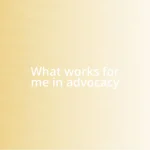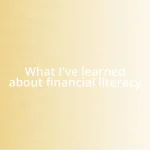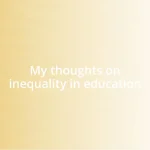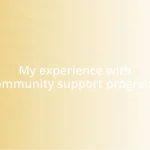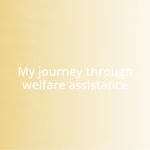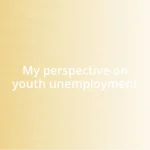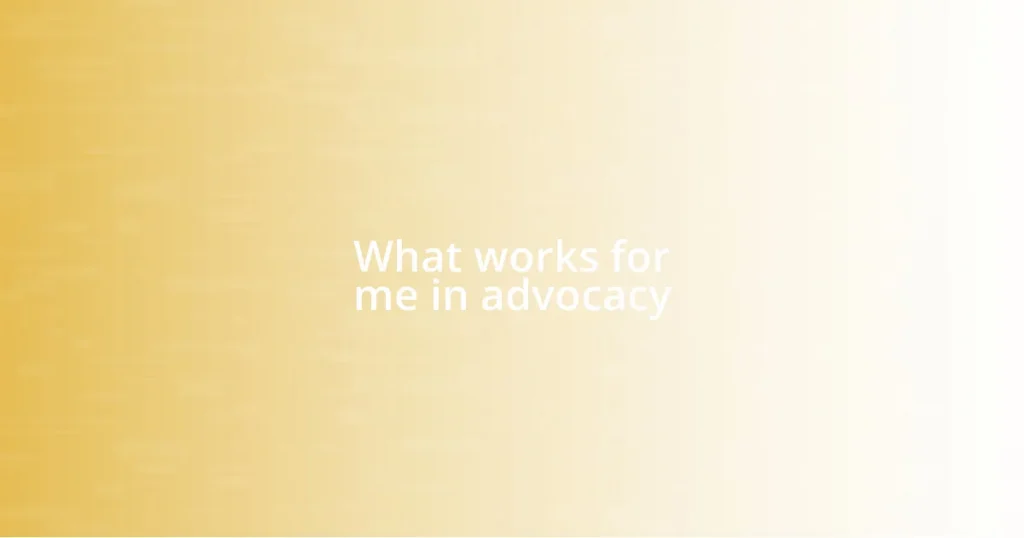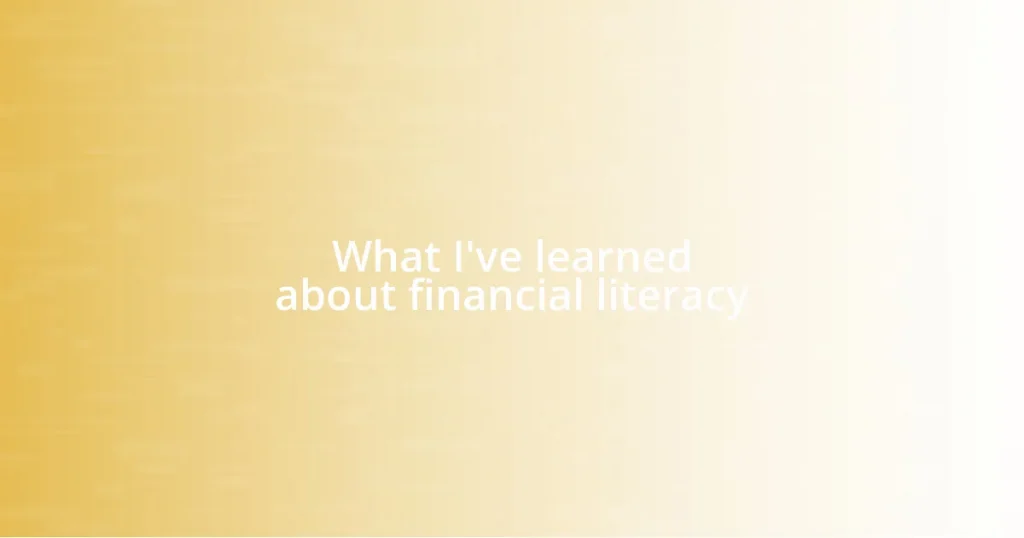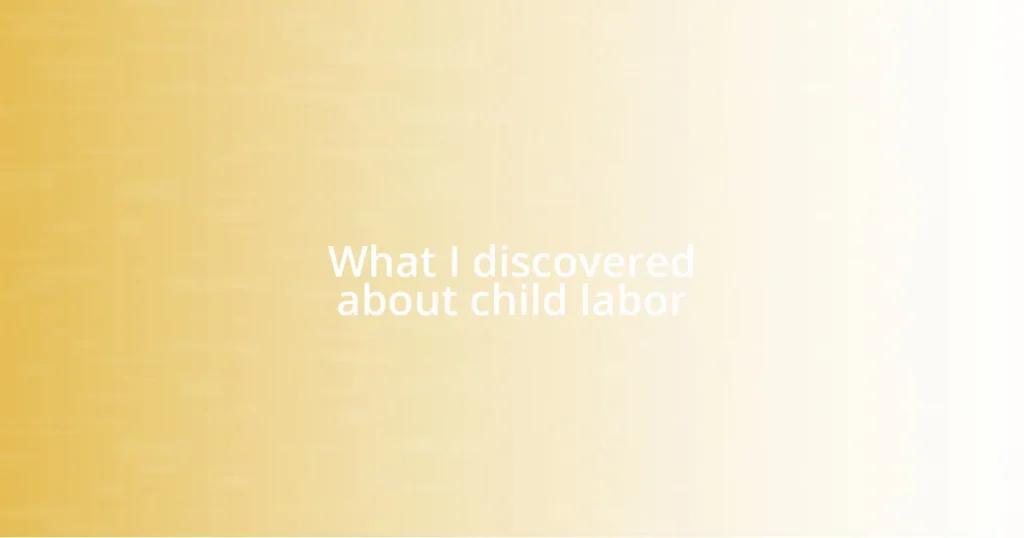Key takeaways:
- Researching children’s rights revealed the importance of listening to children’s voices, which offers valuable insights into policy gaps and challenges they face.
- Engaging local stakeholders fostered collaboration and addressed community-specific needs, enhancing the event’s relevance and impact.
- Effective event promotion leveraged personal stories and community involvement, creating a compelling narrative that resonated with attendees.
- Evaluating event outcomes highlighted the emotional impact on children and parents, reinforcing the importance of creating safe spaces for dialogue around children’s rights.

Researching children’s rights topics
Diving into the realm of children’s rights topics can feel overwhelming, but it’s also a journey filled with revelations. I remember the first time I stumbled upon the Convention on the Rights of the Child; it was like unearthing a treasure trove of knowledge. The idea that every child deserves a safe environment to grow up in struck a chord with me—what kind of world are we creating when so many kids don’t experience this fundamental right?
As I researched various topics, I found it crucial to listen to the voices of children themselves. I once attended a workshop where young participants shared their experiences about education. Their stories were eye-opening, highlighting not only their struggles but also their hopes. Isn’t it fascinating how their insights can guide us in addressing policy gaps? It’s almost as if they have a unique lens through which we can better understand the real issues at hand.
Moreover, I sought out reports from organizations dedicated to children’s rights, pouring over statistics and case studies. The stark differences in rights enforcement worldwide were shocking. How can we stand idly by when some children face obstacles unimaginable in other countries? Each piece of research not only informed my understanding but also ignited a passion within me to advocate for these rights.

Engaging with local stakeholders
Engaging with local stakeholders was a pivotal aspect of organizing my event. I reached out to local schools, community organizations, and child advocacy groups, sharing my vision and inviting them to collaborate. I vividly recall a meeting with a local teacher who was passionate about children’s rights; her enthusiasm was contagious and pushed me to broaden our event’s scope to include educational workshops.
Fostering these connections allowed us to tap into their expertise and gain valuable insights about the community’s specific needs. For instance, I learned from a local NGO that many families in our area struggled with access to mental health resources for children. This information changed the direction of our event, enabling us to incorporate a panel discussion that addressed this pressing issue. Isn’t it amazing how the right conversations can elevate an initiative?
What truly stood out were the diverse perspectives gathered through our stakeholder engagements. One unexpected ally was a local business owner who offered his space for the event, coupled with a heartfelt commitment to child welfare. These experiences taught me that forming partnerships isn’t just about logistics; it’s about building a shared passion that resonates throughout the community.
| Stakeholder Type | Role in Event |
|---|---|
| Local Schools | Provided student participation and insights on relevant topics. |
| NGOs | Offered resources and expertise related to children’s rights. |
| Community Organizations | Helped promote the event and engage local families. |
| Businesses | Supplied venue and sponsorship, enhancing community involvement. |

Planning event logistics and activities
I learned that planning event logistics is as much about the details as it is about the atmosphere you want to create. I vividly remember sketching out the layout for our venue—one corner for discussions, another for activities. Visualizing the space helped me feel how participants would flow through the event. I always aimed for an inviting and accessible environment where everyone felt welcome. A well-structured timeline also played a key role, guiding the event from start to finish without a hitch.
Here’s a quick checklist I found invaluable during the planning phase:
- Venue Selection: Choose a location that is accessible and welcoming to families.
- Timetable: Create a precise schedule, including breaks for networking.
- Activity Planning: Decide on interactive workshops, discussions, or games that resonate with children’s rights themes.
- Supplies and Staffing: Ensure you have all materials ready and volunteers briefed on their roles.
- Promotion: Develop a strategy to get the word out, including flyers, social media, and community boards.
Each step felt like building a bridge towards a meaningful event, where I hoped deep conversations would take place. In organizing the activities, I focused on including fun yet educational elements, such as arts and crafts that centered around children’s rights. I could almost see their faces lighting up as they created posters highlighting key messages. This kind of engagement truly brought the topic to life in a way that statistics alone could never achieve.

Promoting the event effectively
Promoting the event effectively required a multi-faceted approach that I found both exciting and challenging. I vividly remember the brainstorming session I had with a few volunteers, where we threw around ideas that ranged from social media campaigns to engaging local influencers. One idea that really stuck was creating a hashtag for our event. It felt like a spark of inspiration, and watching it take off on social platforms filled me with joy. Engaging directly with the community online not only generated buzz but also fostered a sense of ownership among the participants.
I also tapped into the power of visual storytelling. During promotional meetings, I shared my own experiences regarding children’s rights, which resonated deeply with many attendees. Seeing the excitement in their eyes as I recounted how I’d learned about these issues as a child made me realize that personal stories create a connection that facts alone can’t achieve. Could anyone truly resist being part of a narrative that champions the welfare of children? I don’t think so. By sharing these personal anecdotes in our promotional materials, I helped potential attendees understand the emotional significance behind the event.
Moreover, I found that collaborating with local artists to create eye-catching promotional materials added an authentic touch. I was genuinely moved when one artist said my campaign had inspired her to advocate for children’s rights through her art. This partnership not only broadened our reach but also infused creativity into our message, making it stand out in a crowded landscape. In my experience, when you align the event’s promotion with heartfelt contributions from the community, it transforms the entire campaign into something memorable and impactful.

Executing the event day
Executing the event day was a whirlwind of emotions and organization. I recall waking up that morning filled with excitement and a hint of nervousness, wondering if everything would go according to plan. I arrived at the venue early to set up and take in the atmosphere. Watching the sun filter through the windows while arranging chairs and tables made me feel hopeful; it was our space now—a place where children’s voices would effectively ring loud and clear.
As attendees began to filter in, I felt my heart swell with pride. It was one thing to plan everything meticulously, but seeing families connecting and smiling as they engaged in activities truly brought it all together. I made sure to circulate while the activities were in full swing, sparking conversations and encouraging children to share their thoughts on their rights. Their faces lit up, and I often found myself thinking: isn’t it inspiring to see young minds so passionate about their place in the world?
Near the end of the day, I stepped back to absorb what had unfolded. I encountered a little girl showing her mother a poster she had created about the right to play, her eyes sparkling with enthusiasm. In that moment, I realized that it wasn’t just about executing an event; it was about nurturing understanding and empowering the next generation. Witnessing a child’s confidence grow when expressing their rights made all the effort we put in worth it. Wouldn’t you agree that creating such moments is something we should strive for in every event?

Evaluating the event outcomes
Once the event wrapped up, I had an exhilarating sense of accomplishment, but I knew evaluating our outcomes was crucial. I vividly remember gathering feedback from attendees. One parent approached me with tears in her eyes, saying that her child felt “heard for the first time.” It struck me how vital it was to create a safe space for children to express themselves and understand their rights. Moments like that deepened my conviction that our efforts truly made a difference.
In the days that followed, I analyzed our attendance numbers and engagement levels. I looked back at the social media interactions, feeling a mix of pride and surprise as I saw the hashtag we created gaining traction online. It wasn’t just about the numbers for me, though; seeing that our narratives resonated with so many people reinforced my belief in the power of shared experiences. How could I not feel motivated to plan a similar event in the future, considering the impact we made?
I also took a moment to reflect on the activities we organized and their effectiveness. Watching children dive into discussions about their rights left a lasting impression on me. One boy passionately shared his thoughts alongside a group of friends, and I couldn’t help but wonder: had we ignited a lifelong passion for advocacy? Evaluating the outcomes wasn’t just about metrics; it was about the connections forged and the empowerment witnessed. Those insights would guide my future endeavors, ensuring that I continued to nurture the dialogue around children’s rights in every event I plan.
